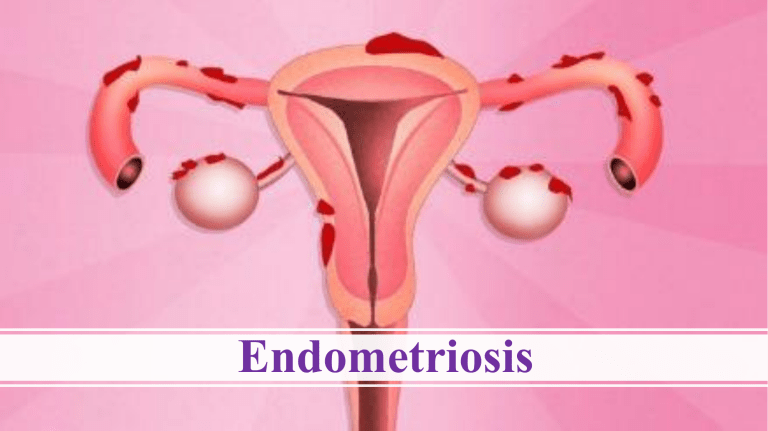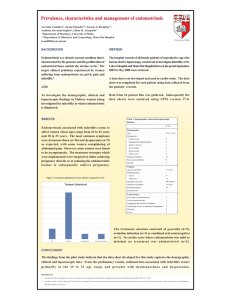
Endometriosis Definition of Endometriosis • Endometriosis is derived from the word “endometrium,” which is the tissue that lines the uterus. • Patients with endometriosis have endometrial-type tissue outside of the uterus Objectives • • • • • • • • What is Endometriosis and its Types. Explain Pathophysiology and its stages. Explain Sign & Symptoms, Cause of Endometriosis. Explain Risk Factors and Medical diagnosis of Endometriosis. Prevention and Common Complication of Endometriosis. Medical Management, Life Style modification of Endometriosis. Surgical management of Endometriosis. Nursing management (Assessment, Diagnosis, Planning, Intervention, evaluation) of Endometriosis. • Teaching Plan of Endometriosis. Types of Endometriosis Here are three main types of endometriosis, based on where it is: • Superficial peritoneal lesion: This is the most common kind. You have lesions on your peritoneum, a thin film that lines your pelvic cavity. • Endometrioma (ovarian lesion): These dark, fluid-filled cysts, also called chocolate cysts, form deep in your ovaries. They don’t respond well to treatment and can damage healthy tissue. • Deeply infiltrating endometriosis: This type grows under your peritoneum and can involve organs near your uterus, such as your bowels or bladder. About 1% to 5% of women with endometriosis have it. Where Endometriosis Can Occur The most common sites of endometriosis include: • The ovaries • The fallopian tubes • Ligaments that support the uterus (uterosacral ligaments) • The posterior cul-de-sac, i.e., the space between the uterus and rectum • The anterior cul-de-sac, i.e., the space between the uterus and bladder • The outer surface of the uterus • The lining of the pelvic cavity. Cont.. Occasionally, endometrial tissue is found in other places, such as: • • • • • The intestines The rectum The bladder The vagina The cervix etc. Pathophysiology of Endometriosis • One of the most common health issues for women today is endometriosis. A very painful disorder. • Endometrial tissue is the one that breaks down and bleeds out along with the egg, during menstrual. So when this tissue starts forming outside of the Uterus, it thickens, breaks down, and bleeds with each menstrual cycle, but now this tissue doesn’t have any way to get out of the body, it gets trapped inside. When this disorder involves the ovaries, it results in cysts, called endometriomas. • Due to this, the surrounding tissue becomes irritated. Eventually, the surrounding tissue may result in scar tissue and adhesions. Apart from this endometriosis can cause severe pain especially during menstrual periods. Stages of Endometriosis A staging system for endometriosis has been developed by the American Society of Reproductive Medicine. The stages are classified as follows: Stage 1: Minimal Stage 2: Mild Stage 3: Moderate Stage 4: Severe Cont.. • The stage of endometriosis is based on the location, amount, depth and size of the endometrial tissue. Specific criteria include: 1. The extent of the spread of the tissue 2. The involvement of pelvic structures in the disease 3. The extent of pelvic adhesions 4. The blockage of the fallopian tubes • The stage of the endometriosis does not necessarily reflect the level of pain experienced, risk of infertility or symptoms present. For example, it is possible for a woman in stage 1 to be in tremendous pain, while a woman in stage 4 may be asymptomatic. Endometriosis sign and Symptoms The following are the most common symptoms for endometriosis, but each woman may experience symptoms differently or some may not exhibit any symptoms at all. Symptoms of endometriosis may include: • Pain, especially excessive menstrual cramps that may be felt in the abdomen or lower back • Pain during intercourse • Abnormal or heavy menstrual flow • Infertility • Painful urination during menstrual periods • Painful bowel movements during menstrual periods • Other gastrointestinal problems, such as diarrhea, constipation and/or nausea Cont.. • It is important to note that the amount of pain a woman experiences is not necessarily related to the severity of the disease. Some women with severe endometriosis may experience no pain, while others with a milder form of the disease may have severe pain or other symptoms. Eiman Presenter (Roll No: 22) Causes of Endometriosis • Retrograde menstruation: Doctors don’t know exactly what causes endometriosis. Some experts think menstrual blood that contains endometrial cells may pass back through your fallopian tubes and into your pelvic cavity, where the cells stick to your organs. This is called Retrograde menstruation. • Surgical scar implantation: After a surgery, such as a hysterectomy or Csection, endometrial cells may attach to a surgical incision. • Endometrial cell transport: The blood vessels or tissue fluid (lymphatic) system may transport endometrial cells to other parts of the body. • Immune system disorder: A problem with the immune system may make the body unable to recognize and destroy endometrial-like tissue that's growing outside the uterus. Risk Factors of Endometriosis Apart from the above causes, mentioned below are a few factors that have proved to be a catalyst in developing endometriosis: • Choosing to never give birth • Commencement of periods at an early age • Commencement of menopause at an older age • Short menstrual cycles (less than 27 days) • Heavy menstrual periods that also last for more than seven days • Having high levels of estrogen (also if the release of estrogen is a lot more than usual) • Lower body mass index • Blood relatives having endometriosis • Any medical condition that prevents the normal menstrual flow out of the body • Abnormalities in the reproductive tract Diagnosis of Endometriosis Doctor might suspect endometriosis based on your symptoms. To confirm it, they can do tests including: • Pelvic exam: Your doctor might be able to feel cysts or scars behind your uterus. • Imaging tests: An ultrasound, a CT scan, or an MRI can make detailed pictures of your organs. • Laparoscopy: Your doctor makes a small cut in your belly and inserts a thin tube with a camera on the end (called a laparoscope). They can see where and how big lesions are. This is usually the only way to be totally certain that you have endometriosis. • Biopsy: Your doctor takes a sample of tissue, often during a laparoscopy, and a specialist looks at it under a microscope to confirm the diagnosis. • Talk to your doctor about hormonal birth control methods, such as pills, patches or rings with lower doses of estrogen. • Exercise regularly (more than 4 hours a week) Preventions • Avoid large amounts of alcohol. • Avoid large amount of drinks with caffeine. common complications Endometriosis If not treated, endometriosis can lead to complications such as: • Infertility. • Debilitating pelvic pain. • Adhesions and ovarian cysts. • Bladder or bowel problems. • Pelvic infection. • Possible higher risk of ovarian cancer. • Esha Imtaiz Presenter (Roll No:25) Medical Management • Therapies used to treat endometriosis include: • Hormonal contraceptives. Birth control pills, patches and vaginal rings help control the hormones responsible for the buildup of endometrial tissue each month. • Gonadotropin-releasing hormone (GnRH) agonists and antagonists. • Progestin therapy. • Aromatase inhibitors. Life style modification • Lifestyle and home remedies • If your pain persists or if finding a treatment that works takes some time, you can try measures at home to relieve your discomfort. • Warm baths and a heating pad can help relax pelvic muscles, reducing cramping and pain. • Over-the-counter nonsteroidal anti-inflammatory drugs (NSAIDs), such as ibuprofen (Advil, Motrin IB, others) or naproxen sodium (Aleve), can help ease painful menstrual cramps. SURGICAL MANAGEMENT • Surgically endometriosis can be treated either by laparoscopy or by hysterectomy. ❑Laparoscopy: • In laparoscopic surgery, your surgeon inserts a slender viewing instrument (laparoscope) through a small incision near your navel and inserts instruments to remove endometrial tissue through another small incision. After surgery, your doctor may recommend taking hormone medication to help improve pain. ❑Hysterectomy: • Removal of the uterus (hysterectomy) can sometimes be used to treat signs and symptoms associated with endometriosis, such as heavy menstrual bleeding and painful menses due to uterine cramping, in those who don't want to become pregnant. Even when the ovaries are left in place, a hysterectomy may still have a long-term effect on your health, especially if you have the surgery before age 35. Eman Manzoor Presenter (Roll No:23) NURSING MANAGEMENT Assessment : • Offer an abdominal and pelvic examination to women with suspected endometriosis to identify abdominal masses and pelvic signs, such as reduced organ mobility and enlargement, tender nodularity in the posterior vaginal fornix, and visible vaginal endometriosis lesions. • If a pelvic examination is not appropriate, offer an abdominal examination to exclude abdominal masses. Nursing Diagnoses • Chronic pain related to endometrial pelvic implants • Anxiety related to effect of endometriosis on fertility • Deficient knowledge related to diagnosis and treatment options • Ineffective sexuality patterns related to the manifestations of endometriosis • Relief of pain • Dysmenorrhea • Dyspareunia Planning • Dispel myths and encourage the patient to seek care if dysmenorrhea or dyspareunia occur • Support group for women with endometriosis problem • Sometime it helps simply to talk to women who can relate to your feelings and experience Intervention • Encourage the patient and her partner to verbalize their feelings about the disorder and its effect on their relationship. • Help the patient develop effective coping strategies. • If the patient bleeds excessively with menses, monitor for signs and symptoms of anemia. • Check hemoglobin level as ordered. Cont.. • Monitor the patients response to therapy. • Explain all the procedures and treatment options. Clarify any misconceptions about the disorder, associated complications, and fertility. • Because infertility is possible complication, counsel the patient who wants children not to postpone childbearing. • Recommend that the patient have an annual pelvic examination and a Papanicolaou test. • Teach the patient about the adverse effects of pharmacologic interventions. Evaluation: • Evaluate the effectiveness of nursing interventions by checking the progress timely Teaching plan • • • • • Rest, relax and meditate. Take warm baths. Prevent constipation. Get regular exercise. Use a hot water bottle or heating pad on your abdomen. • Lie down and put a pillow under your knees to raise your legs. This will relieve pressure on your back. • Take pain medicine exactly as directed. References • https://www.mayoclinic.org/diseases-conditions/endometriosis/diagnosis-treatment/drc20354661 • https://womenfitnessmag.com/what-is-endometriosis-how-does-it-affect-fertility/ • https://www.hopkinsmedicine.org/health/conditions-and-diseases/endometriosis • https://images.app.goo.gl/CBRvSKNEJrckddZC6 • https://www.hopkinsmedicine.org/health/conditions-and-diseases/endometriosis • https://www.healthline.com/health/womens-health/endometriosis-pain-relief • https://www.hopkinsmedicine.org/gynecology_obstetrics/specialty_areas/endometriosis/ Thank You..




